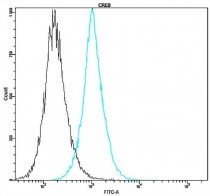ARG10561
anti-CREB antibody [A17-A] (FITC)
anti-CREB antibody [A17-A] (FITC) for Flow cytometry and Human
Overview
| Product Description | FITC-conjugated Rabbit Monoclonal antibody [A17-A] recognizes CREB |
|---|---|
| Tested Reactivity | Hu |
| Tested Application | FACS |
| Host | Rabbit |
| Clonality | Monoclonal |
| Clone | A17-A |
| Isotype | IgG |
| Target Name | CREB |
| Antigen Species | Human |
| Conjugation | FITC |
| Alternate Names | Cyclic AMP-responsive element-binding protein 1; CREB; CREB-1; cAMP-responsive element-binding protein 1 |
Application Instructions
| Application Suggestion |
|
||||
|---|---|---|---|---|---|
| Application Note | * The dilutions indicate recommended starting dilutions and the optimal dilutions or concentrations should be determined by the scientist. |
Properties
| Form | Liquid |
|---|---|
| Buffer | Aqueous buffer solution, 0.05% Sodium azide and 10 mg/ml BSA |
| Preservative | 0.05% Sodium azide |
| Stabilizer | 10 mg/ml BSA |
| Storage Instruction | Aliquot and store in the dark at 2-8°C. Keep protected from prolonged exposure to light. Avoid repeated freeze/thaw cycles. Suggest spin the vial prior to opening. The antibody solution should be gently mixed before use. |
| Note | For laboratory research only, not for drug, diagnostic or other use. |
Bioinformation
| Database Links |
Swiss-port # P16220 Human Cyclic AMP-responsive element-binding protein 1 |
|---|---|
| Gene Symbol | CREB1 |
| Gene Full Name | cAMP responsive element binding protein 1 |
| Background | CREB is a transcription factor. It is a member of the leucine zipper family of DNA binding proteins. This protein binds as a homodimer to the cAMP-responsive element, an octameric palindrome. The protein is phosphorylated by several protein kinases, and induces transcription of genes in response to hormonal stimulation of the cAMP pathway. Alternate splicing of this gene results in several transcript variants encoding different isoforms. [provided by RefSeq, Mar 2016] |
| Function | CREB is a phosphorylation-dependent transcription factor. It stimulates transcription upon binding to the DNA cAMP response element (CRE), a sequence present in many viral and cellular promoters. Transcription activation is enhanced by the TORC coactivators which act independently of Ser-133 phosphorylation. Involved in different cellular processes including the synchronization of circadian rhythmicity and the differentiation of adipose cells. [UniProt] |
| Calculated MW | 37 kDa |
| PTM | Stimulated by phosphorylation. Phosphorylation of both Ser-133 and Ser-142 in the SCN regulates the activity of CREB and participates in circadian rhythm generation. Phosphorylation of Ser-133 allows CREBBP binding. In liver, phosphorylation is induced by fasting or glucagon in a circadian fashion (By similarity). CREBL2 positively regulates phosphorylation at Ser-133 thereby stimulating CREB1 transcriptional activity (By similarity). Phosphorylated upon calcium influx by CaMK4 and CaMK2 on Ser-133. CaMK4 is much more potent than CaMK2 in activating CREB. Phosphorylated by CaMK2 on Ser-142. Phosphorylation of Ser-142 blocks CREB-mediated transcription even when Ser-133 is phosphorylated. Phosphorylated by CaMK1 (By similarity). Phosphorylation of Ser-271 by HIPK2 in response to genotoxic stress promotes CREB1 activity, facilitating the recruitment of the coactivator CBP. Phosphorylated at Ser-133 by RPS6KA3, RPS6KA4 and RPS6KA5 in response to mitogenic or stress stimuli. Sumoylated with SUMO1. Sumoylation on Lys-304, but not on Lys-285, is required for nuclear localization of this protein. Sumoylation is enhanced under hypoxia, promoting nuclear localization and stabilization. |
Images (1) Click the Picture to Zoom In






